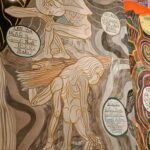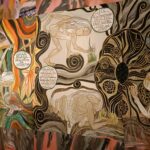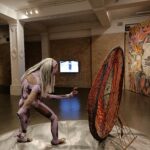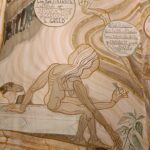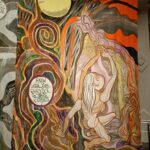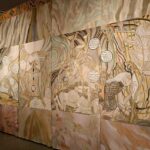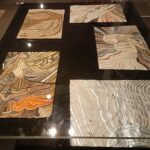London calling | chapter 5
Emma Talbot
The Age / L’Età
ITA (English below)
Nel suo ultimo lavoro Emma Talbot si concentra sulle strutture di potere che sorreggono la società e sulle possibili soluzioni di riformularle per affrontare le sfide contemporanee e future. Dopo la presentazione alla Whitechapel Gallery di Londra, The Age / L’Età è attualmente esposta alla Collezione Maramotti di Reggio Emilia.
La vita è un processo trasformativo
Continua a imparare e adattarti
Al centro del suo ultimo lavoro, The Age / L’Età, Emma Talbot (1969) pone le imprese di una donna anziana, un personaggio pensato dalla stessa artista: “come la sopravvissuta di un’epoca futura […] post-apocalittica. Mi sono chiesta come lei, o io stessa, avrebbe potuto continuare a vivere in assenza delle strutture fondamentali della vita di tutti i giorni e ho immaginato che avrebbe fatto affidamento su principi come la cura, il mutualismo, il commensalismo e la pazienza per trovare il modo di andare avanti”.
The Age / L’Età è il progetto con il quale l’artista britannica si è aggiudicata il Max Mara Prize for Women 2019, edizione rimandata al 2022 a causa della pandemia covid. Il premio, ideato e promosso dalla Collezione Maramotti di Reggio Emilia in collaborazione con la Whitechapel Gallery di Londra, è dedicato ad artiste britanniche che non hanno ancora esposto in una antologica personale. Oltre a dare spazio e visibilità alle artiste, il premio organizza anche una residenza in Italia: nel caso della Talbot, la residenza di sei mesi, si è svolta tra Reggio Emilia, Catania e Roma.
The Age / L’Età è quindi il risultato della ricerca effettuata in Italia, dove l’artista britannica ha avuto l’opportunità di dedicarsi a svariati studi, dall’artigianato tessile e lo sviluppo di materiali riciclati alla mitologia classica, dall’arte vascolare etrusca alla permacultura, quest’ultima presso la Casa di paglia Felcerossa, a Sant’Alfio, paese situato sulle pendici dell’Etna.
Impara a bilanciare
osservazione e interazione
Per il personaggio della donna anziana, l’artista ha preso spunto dal dipinto Le Tre Età della Donna (1905) di Gustav Klimt, conservato alla Galleria Nazionale di Roma e studiato, appunto, durante il suo soggiorno in Italia. In questo dipinto, alle due figure di una giovane donna e una bambina, il pittore austriaco affianca l’immagine di una donna anziana dai capelli grigi e con le mani sul volto inchinato: “inerte, incapace e carica di vergogna”, come descrive la Talbot. L’artista intravede in questo dipinto un duplice aspetto del patriarcato che, oltre a condannare la donna per la propria età avanzata e non più fertile, denigra la sapienza femminile sostituendola con un “razionalismo che è prerogativa esclusiva del maschio”.
Usa e valorizza la diversità
In The Age / L’Età, la donna anziana, la quale è dipinta priva di connotati, è una figura attiva, dinamica e ricca di saggezza; nei due grandi pannelli di seta, installati l’uno di fronte all’altro, la donna lavora, si prende cura di animali e piante, esplora paesaggi rocciosi. Nello stesso tempo, comunica e dispensa la propria saggezza, attraverso dei precetti che richiamano alla tolleranza, alla pazienza e al rispetto delle proprie e altrui esigenze.
Nel lavoro di animazione, effettuato dalla Talbot durante il lockdown, la donna affronta dodici prove, le quali riprendono le famose fatiche di Ercole. Al contrario dell’eroe classico, la donna affronta tali fatiche non ricorrendo alla violenza, all’inganno o alla distruzione generale, ma facendo riferimento ai dodici principi della permacultura, pratica che mira ad un uso etico e sostenibile delle risorse naturali.
Per esempio, nella prova del leone di Nemea, la prima delle fatiche di Ercole, nella quale l’eroe greco strangola a mani nude l’animale e si appropria della sua pelle, invulnerabile a qualsiasi arma umana, la donna prova a comprendere i bisogni del leone, in modo di risolvere i problemi di coesistenza. I due conversano e capiscono che, non solo possono coesistere, ma possono anche (ri)appropriarsi e valorizzare la loro stessa immagine contro il potere del patriarcato che si nutre dell’altrui immagine (pelle nel caso del leone) per accrescere il proprio potere.
Usa soluzioni piccole e lente
Come afferma l’artista stessa: “Ho cercato di trattare le fatiche come esperimenti di pensiero – di elaborare quali significati potessero relazionarsi con ognuna di esse, in che modo potessero essere interpretate come condizioni contemporanee, e come la protagonista potrebbe proporre soluzioni alternative”. Associando la figura della donna anziana alle dodici fatiche ercoline, la Talbot mira a toccare diversi temi, dalla sostenibilità all’emergenza climatica, dal progresso tecnologico alla disparità di genere.
Allo stesso modo, interpellando i precetti della permacultura, l’artista tenta di espandere il loro utilizzo al di fuori del loro valore pratico: “I principi della permacultura si fondano essenzialmente su pratiche e progetti di ecosistemi per l’agricoltura che sono sostenibili e autosufficienti. Ma sono anche abbastanza ampi da poter essere intesi come principi generali per la vita”.
Come con le altre sue opere, tra le quali Where Do We Come From, What Are We, Where Are Going? (2021) esposta alla Biennale d’Arte di Venezia 2022, la Talbot pone e cerca di far porre al fruitore dell’opera dei quesiti riguardo le condizioni attuali del mondo, le cause storiche ad esse correlate e le possibili alternative a quei sistemi distruttivi che hanno favorito tali condizioni.
In che età ci troviamo?
Un’era ostile dove il danno è parte del linguaggio di autorità vili
che evocano storie
nelle quali tu sei invisibile
per parlare di potere
* * *
ENG
In her latest work Emma Talbot focuses on the power structures that underpin society and the possible solutions to reformulate them to face contemporary and future challenges. After being presented at Whitechapel Gallery in London, The Age / L’Età is currently exhibited at Collezione Maramotti in Reggio Emilia.
Life is a transformative process
Keep learning and adapting
At the center of her latest work, The Age / L’Età, Emma Talbot (1969) places the exploits of an elderly woman, a character thought by the artist: “as a future survivor […] following an apocalyptic event. I wondered how she, or I, might function without the basic structures of everyday life, and imagined that she might turn to principles like care, mutualism, commensalism and patience to find ways forward”.
The Age / The Età is the project with which the British artist won the Max Mara Prize for Women 2019, an edition postponed to 2022 due to the covid pandemic. The award, conceived and promoted by the Collezione Maramotti, Reggio Emilia, in collaboration with Whitechapel Gallery in London, is dedicated to British women artists who have not yet exhibited in a personal anthology. In addition to giving space and visibility to the artists, the award also organizes a residency in Italy: in the case of Talbot, the six-month residency took place between Reggio Emilia, Catania and Rome.
The Age / The Età is therefore the result of the research carried out in Italy, where the British artist had the opportunity to devote herself to various studies, from textile craftsmanship and the development of recycled materials to classical mythology, from vascular Etruscan art to permaculture, the latter at the Casa della Paglia Felcerossa in Sant’Alfio, a town located on the slopes of Etna.
Learn to Balance
Observation and Interaction
For the character of the elderly woman, the artist was inspired by the painting The Three Ages of Woman (1905) by Gustav Klimt, kept at the Galleria Nazionale in Rome and studied during her stay in Italy. In this painting, the Austrian painter has added, to the two figures of a young woman and a child, the image of an elderly woman with gray hair and with her hands on her bowed face, “inert, incapable and ashamed”, as Talbot says. The artist sees in this painting a dual aspect of patriarchy which, in addition to condemning women for their advanced and no longer fertile age, denigrates female wisdom by replacing it with a “rationalism that is the sole province of the male”.
Use and value diversity
In The Age / L’Età, the elderly woman, who is depicted with no connotations, is an active, dynamic and full of wisdom figure; in the two large silk panels, installed facing each other, the woman works, takes care of animals and plants, explores rocky landscapes. At the same time, she communicates and dispenses her own wisdom, through precepts that call for tolerance, patience and respect for one’s own and others’ needs.
In the work of animation, carried out by Talbot during the lockdown, the woman comes across twelve trials, which resume the famous Twelve Labors of Hercules. Unlike the classic hero, the woman faces these labors not by resorting to violence, deception or general destruction, but by referring to the twelve principles of permaculture, a practice that aims at an ethical and sustainable use of natural resources.
For example, in the trial of the Nemean lion, the first of Hercules’ labors, in which the Greek hero strangles the animal with his bare hands and appropriates its skin, invulnerable to any human weapon, the woman tries to understand the lion’s needs, in order to solve the problems of coexistence. The two converse and understand that, not only can they coexist, but they can also (re) appropriate and enhance their own image against the power of patriarchy that feeds on the image of others (skin in the case of the lion) to enhance their own power.
Use small and slow solutions
Regarding the trials, the artist states: “I decided to treat them as thought experiments – to work out what meanings could be attached to each of the trials, how they could be interpreted as contemporary conditions and how the protagonist could propose alternative solutions”. By associating the figure of the elderly woman with the twelve Herculean labors, Talbot aims to touch on various themes, from sustainability to the climate emergency, from technological progress to gender inequality.
Similarly, by questioning the precepts of permaculture, the artist attempts to expand their use beyond their practical value: “The principles of permaculture are primarily based in practices and designs for agricultural ecosystems that are sustainable and self-sufficient. However, they are broad enough to be understood as general principles for life”.
As with her other works, including Where Do We Come From, What Are We, Where Are Going? (2021) exhibited at the Venice Biennale of Art 2022, Talbot poses and tries to ask the viewer of the work some questions about the current conditions of the world, the historical causes related to them and the possible alternatives to those destructive systems that favored such conditions.
What age are in?
A hostile era where damage is part of the language of vile authorities
that evoke histories
where you are invisible
to speak of power


